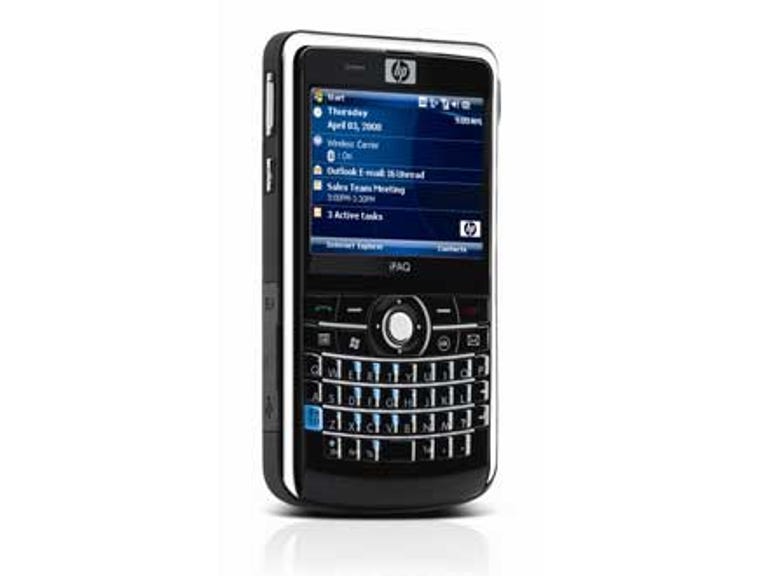 Why You Can Trust CNET
Why You Can Trust CNET HP iPAQ 912c review: HP iPAQ 912c
The HP iPAQ 912c defines the middle of the road. When you consider its performance versus the price, the 912c is passable but painfully average.
Design
HP has done its homework. The 912c's pragmatic design is far from revolutionary, but the company has been smart enough to pinch a few good ideas from its competition. In addition to the standard menu navigation keys, there is an OK button used to close active windows, common to Palm smartphones, and on the right side of the handset HP has included a jogwheel reminiscent of the last generation of BlackBerrys. Both of these elements are simple inclusions but certainly make for faster navigation.
The Good
The Bad
The Bottom Line
The 912c's dimensions (114mm tall, 54mm wide and 15mm deep) seems no bigger than other Windows Mobile (WM) devices we've seen, but its 154g weight is noticeably heavier, due in part to its enormous battery. The 912c also features a reasonably high spec camera compared to most WM smartphones; a 3-megapixel shooter with an LED flash and auto-focus.
The iPAQ 912c makes use of a full QWERTY keyboard for speedy text entry, similar to most other smartphones in the market. The keyboard is comprised of four rows of raised rounded keys. Raising the keys does give each button some definition, but overall we found this keypad hard to navigate at top speed, with two thumbs typing being next to impossible.
Above the QWERTY keyboard the 912c features a 2.4-inch colour TFT touchscreen display. We found that we didn't use the touchscreen much, the menus were often faster to navigate using the five-way nav button, but we do like to have the option to slap at the screen open to us, plus the 912c comes with an excellent telescopic stylus. We don't recommend relying on this display outside under natural light. While the screens on most phones lose clarity under sunlight, the 912c's display becomes completely unreadable.
Features
HP has employed Windows Mobile 6.1 professional on this latest iPAQ. Browsing through the iPAQ program folder is similar to browsing through the same folder on Palm's Treo Pro, with a few notable exceptions. HP has included several self-branded applications including the HP Photosmart Mobile used to view and modify photos taken with the phone's camera, with the ability to send the photos to a compatible printer via Wi-Fi or Bluetooth.
Following suit with most of its competitors HP has included all major connectivity features. Tri-band UMTS reception with HSDPA for fast Web access, Wi-Fi, Bluetooth and A-GPS. Of course, just as important as the hardware is, the necessary software is where the iPAQ is lacking somewhat. Similar to the Palm Treo Pro we reviewed recently, the 912c lacks a dedicated navigation solution, rendering the A-GPS hardware almost entirely useless. HP has pre-installed Google Maps which will work with the built-in GPS, but it won't offer any sort of turn-by-turn voice-guided navigation.
Performance
Ladies and gentleman, welcome to the middle of the road. The HP iPAQ 912c fits neatly between the best performing smartphone we've reviewed and some of the worst. Its 412MHz ARM processor and 128MB RAM handle most basic tasks well, but lag spikes are evident, for example, opening the contacts menu, and navigating through the various phone settings. Once we had opened several applications we started to see the 912c struggle.
The most confusing part of reviewing the iPAQ 912c has been trying to ascertain its average battery life. Often this is a simple process, most phones show consistent battery cycles; however, the iPAQ has been considerably different. Firstly its 1940mAh battery capacity is enormous, most smartphone pack batteries around the 1200mAh mark, but even still we saw the battery drain in around 20 hours with extremely light use on the first and second day.
When we observed the phone closer we discovered that it was inexplicably bringing itself out of standby, powering the screen and seemingly performing a task in the background although we couldn't see what task this was. At times the iPAQ would chew through 10 per cent of the battery's charge in a single hour on standby. No sooner had we pinpointed the issue that it stopped, the third day the battery life was exponentially better and the device seemed to stop turning itself on and off. This seems to suggest a software instability rather than a dodgy battery, and it might be something worth keeping an eye on if you choose the iPAQ 912c to do your business.
The rest of our tests found garnered unremarkable results. The HSDPA hardware works well and Web browsing using the Internet Explorer browser was fine, but the touchscreen controls are far from the most intuitive. Making and receiving calls with the iPAQ, we found the speaker to be audible but quieter than we'd have liked at full volume.
Overall
Our problems with the battery have sullied an otherwise average smartphone experience, but at least it made testing the iPAQ 912c somewhat interesting. Like its average performance the 912c's RRP of AU$799 is halfway between the cheapest Windows Mobile devices, like the ASUS M530W at AU$650 and the AU$1,000 price tag on higher end models like the HTC Touch Diamond. As a bog-standard Windows Mobile device we'd recommend the 912c for business users, just be sure to keep an eye on that pesky battery life.


